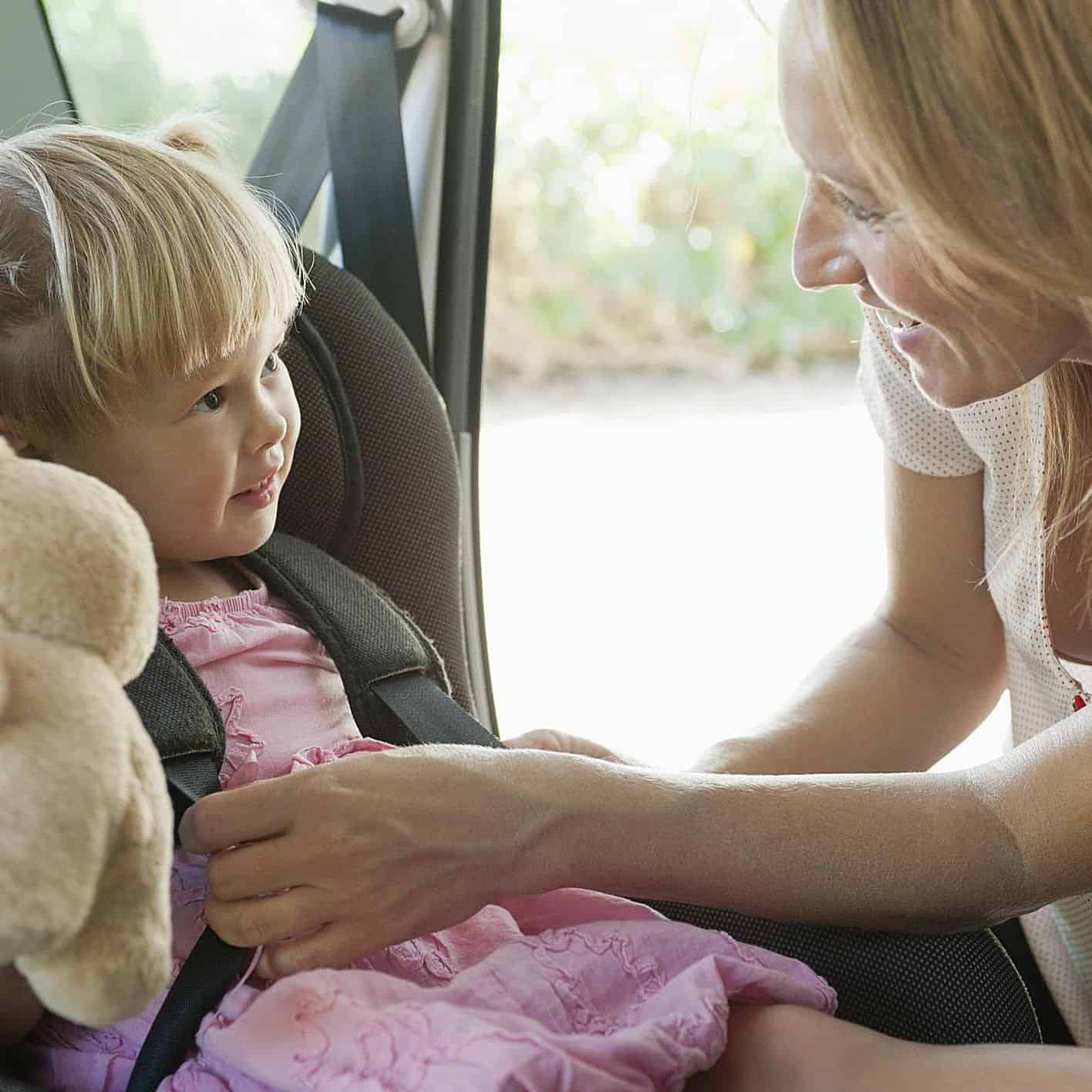Ohio has some of the most relaxed car seat laws in the United States. But that doesn’t mean you can do whatever you want with your kids. There are still rules to follow – and just because something is legal doesn’t mean you should do it.
Just keep reading our guide, and we’ll let you know everything you need to know when traveling with your kiddo in Ohio, including all applicable laws and all recommended safety standards. Car seat laws Ohio are refreshed and applied for 2020
Ohio Laws for Children Under the Age of 4

Ohio has one law for children under the age of 4. If a child is younger than 4 years old and less then 40 pounds, they must “use a child safety seat meeting federal motor vehicle safety standards.”
What that means is the car seat that you are utilizing must be certified by the Federal Motor Vehicle Safety Standard 213, which certifies all car seats in the United States.
Just about any car seat that you buy in the store will be certified by this organization. However, if you’re looking for information on how to identify if your car seat is licensed, check out this article released by Consumer Reports.
Even if you are utilizing a certified car seat, you still need to ensure that the manufacturer designed the car seat that you are using to fit your child. Each car seat manufacturer will set guidelines for using their car seat and the size children they designed it for. The federal government only certified those car seats for children within those age/size ranges.
While this is the only car seat law on the books in Ohio for children under the age of 4, we highly recommend reading our “Why Car Seats Matter” section below to understand further all of the safety recommendations put out by the National Highway Safety and Traffic Association (NHTSA) – and why they matter.
Ohio Laws for Children Under the Age of 8
Just like for children under the age of 4, Ohio has one law for children between the ages of 4 and 7. Children under the age of 8 and 4’9″ must use a booster seat. Once a child is either 8 years old, or over 4’9″ they are no longer legally obligated to use a booster seat in Ohio.
However, this goes against the NHTSA’s safety recommendations regarding the safest way for children to travel in motor vehicles.
Ohio Laws for Children Under the Age of 15

Believe it or not, Ohio has a car seat law for children between the ages of 8 and 15. That’s because, unlike most states, Ohio does not require everyone to wear a seatbelt in the car. Once you reach the age of 15, you don’t have to wear a seatbelt while sitting in the back seat of a vehicle.
So, what’s the law in Ohio for children under the age of 15? They have to wear a seatbelt at all times while in the vehicle, regardless of where they are seated. Keep reading below for information put out by the NHTSA on why seat belts matter and how they save lives.
Why Car Seats Matter
Car seats save lives. It really is as simple as that. But how car seats save lives is just as important as the fact that they do. Because if you aren’t utilizing a car seat correctly, your child can still end up seriously injured, or even worse, dead.
Advantages of Rear Facing Car Seats
The experts are not divided on this one. It would be best if you keep your child rear-facing as long as possible. They can stay rear-facing until their fourth birthday. As long as your child has not outgrown their rear-facing car seat, the NHTSA recommends that you keep them rear-facing.
But why does it matter? The American Association of Pediatrics has conducted multiple studies and broke down the physics of car crashes and how they affect your children. The truth of the matter is that while your child is rear-facing, this pushes their head against the car seat in the event of an accident.
This might not be comfortable, but it’s far safer than allowing their neck to snap forward unimpeded. This can break their neck, potentially killing them or paralyzing them from the neck down for the rest of their life.
Forward Facing Car Seats vs. Booster Seats
There are advantages to forward-facing car seats as opposed to booster seats. The most significant benefit is that forward-facing car seats utilize five-point harnesses. These spread the impact of a collision across a larger area, allowing their little bodies to absorb more of the impact before suffering a severe injury.
This is why both the American Association of Pediatrics and the NHTSA recommend keeping your child in a forward-facing car seat until they outgrow the recommendations put out by the car seat manufacturer.
The truth of the matter is, the longer your child stays in a forward-facing car seat, the better.
Why Your Child Needs a Booster Seat

It doesn’t matter how old your child is if they are under 4’9″ they should use a booster seat, even if Ohio doesn’t require it—understanding why requires understanding why safety organizations recommend booster seats in the first place. And doing that requires understanding how seatbelts work.
How Seatbelts Work
It might seem like common sense, but a seatbelt keeps you safe by keeping you strapped to your seat in case of an accident. This way, you don’t end up flying through a window or into another passenger.
But what your seatbelt holds you by matters too. Seatbelts have two straps that go across you, one goes across your chest and the other across your lap. In the event of an accident, it’s the one that goes across your chest that does most of the work.
The upper strap is positioned against your rib cage, the toughest part of your body, and thus the best equipped to handle a massive shift in momentum. If the seatbelt is anywhere else, you’re at a far greater risk of sustaining a severe injury, which takes us right back to why your child needs a booster seat.
It Keeps the Seatbelt in the Right Place
Without a booster seat, a child under the height of 4’9″ has a seatbelt resting against their neck instead of their chest. But this isn’t just uncomfortable for your child. If you get into a severe accident, you can break your child’s neck, paralyzing, or killing them.
It’s not worth the risk; keep your child in a car seat until they are at least 4’9″.
A Few More Car Seat Tips
There are many things to keep in mind with car seats, and it can seem a little overwhelming. But if you get into a severe accident, you’ll be thankful that you had everything in place to keep your child as safe as possible.
Don’t Forget that Car Seats Expire
Every car seat has an expiration date. Just like your plastic lawn furniture wears out, so does your child’s safety seat. The difference between the lawn chair and the car seat? The manufacturer designed the car seat to save your child’s life.
Most car seats expire after about 10-years. At this point, the plastic starts to degrade-meaning that you aren’t getting the same level of protection that you would get from a new car seat.
Never Reuse a Car Seat
Once the car seat has been in a moderate to a severe accident, you need to recycle it. Just because you don’t see any apparent defects doesn’t mean that there aren’t any there. The plastic in the car seat could easily have micro-cracks, either on the outside or the inside, that could snap the next time you get into an accident.
Car seats might be expensive, but it’s not worth the risk. It’s also why you should never buy a used car seat from someone you don’t know and trust.
Double Check That It’s Installed Properly

Check your manufacturer’s installation guide. Then double-check it. Then triple-check it. Once you’ve done that, take it somewhere to get checked by a professional. You need to know what you’re doing, and you don’t know what you don’t know.
If you’re looking for places to get your car seat checked, head over to the NHTSA and input your location, and they’ll locate the closest location to you for a car seat check.
Summary
Ohio will fine you between 25 and 75 dollars for violating their car seat laws. But that shouldn’t be the reason you do it. The science behind car seats and automotive safety has come a long way in the last 50 years, and the science is exact, car seats save lives.
The monetary value is a small price to pay, but if your child ends up seriously injured, they’re going to pay that price for the rest of your life. And if they end up dead, that’s a price you’ll have to pay every day for the rest of your life.








